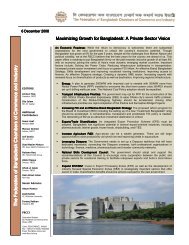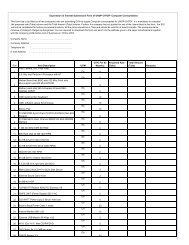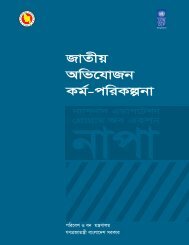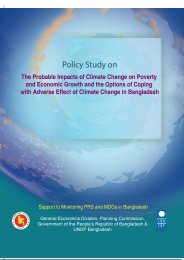Framework for a Strategy of UP Revenue/Resource Mobilisation ...
Framework for a Strategy of UP Revenue/Resource Mobilisation ...
Framework for a Strategy of UP Revenue/Resource Mobilisation ...
Create successful ePaper yourself
Turn your PDF publications into a flip-book with our unique Google optimized e-Paper software.
Most <strong>UP</strong>s appear to be using a cruder system. This involves assessing houses against some general<br />
criteria: number <strong>of</strong> rooms, size <strong>of</strong> rooms, house construction materials, provision <strong>of</strong> tube well and<br />
toilet. Typically, this results in assessment <strong>of</strong> Taka 10-20 <strong>for</strong> a one-room house <strong>of</strong> temporary<br />
materials to Taka 150-250 <strong>for</strong> a four roomed house <strong>of</strong> permanent materials. The resulting<br />
assessment may also be modified by assumptions about the occupier’s ability to pay. Overall, this<br />
method <strong>of</strong> assessment may be acceptable, providing the criteria are clear and applied consistently<br />
and transparently, <strong>for</strong> example, in a open budget meeting. In the end, what matters is not the<br />
absolute value <strong>of</strong> the property but rather a fair distribution <strong>of</strong> the tax burden between households.<br />
But it does require that a clear set <strong>of</strong> criteria is consistently applied and that the process is<br />
sufficiently transparent.<br />
Each <strong>UP</strong> is supposed to have a register <strong>of</strong> all houses 8 , together details <strong>of</strong> the property and the owner<br />
or occupier and the assessed values. These lists were generally compiled more five years ago, and<br />
are now due <strong>for</strong> revision (in one case, the register had not been revised since 1991). It was claimed<br />
that adjustments are made each year <strong>for</strong> new houses or changes to houses. In the <strong>UP</strong>s visited, the<br />
registers were said to have been compiled either using data from a survey conducted by students,<br />
contracted by the <strong>UP</strong> and guided by the <strong>UP</strong> Secretary and councillors, or on a ward basis by <strong>UP</strong><br />
councillors themselves. In some cases, it was claimed, the registers and assessments were compiled<br />
in public meetings. If that is so, it should ensure a degree <strong>of</strong> transparency and fairness. But there are<br />
risks that only certain people attend such meetings, so that others are less fairly treated, although<br />
given the very low levels <strong>of</strong> the assessments, a degree <strong>of</strong> unfairness may not be a major issue.<br />
Where the ARV method is used, the tax rate has to be set (up to 7%) and applied. Where the<br />
simpler system is used, the assessment comes directly to an amount per house, which may or may<br />
not have any relationship to a rate <strong>of</strong> tax on the annual rental value. The tax rate, and the fixed<br />
assessments, appears not to have been changed since the current tax rules came into effect in<br />
2002/03, apart from where there have been changes to individual properties. In most cases, the<br />
resulting tax assessments are very low: Taka 20 – 60 per year in most cases (equivalent to about US<br />
30 – 80 cents), with some at Taka 100 or 200. 9 Exceptionally there are assessments <strong>of</strong> Taka 400 or<br />
500. However, in the <strong>UP</strong>s in Gazipur, on the fringe <strong>of</strong> Dhaka, there were a number houses assessed<br />
8 It is claimed that these registers are completed, but it is possible that some properties are not included, whether<br />
because they are new or <strong>for</strong> some other reason.<br />
9 As an indication <strong>of</strong> how low these tax assessments are, the typical assessment <strong>of</strong> Taka 20 – 60 corresponds to 0.15 –<br />
0.4% <strong>of</strong> the annual minimum wage <strong>of</strong> a garment worker. In one <strong>UP</strong> that had not revised its assessments since 1991,<br />
there were assessments <strong>of</strong> Taka 3 –5, amounts which are now too low to be collectable.<br />
9










